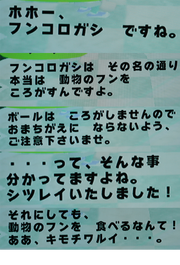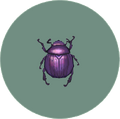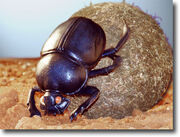- "I caught a dung beetle! Nah, the joke's just too easy." —New Leaf
Dung beetles (フンコロガシ, Fun-korogashi?) in the Animal Crossing series are rare Winter bugs that can only be caught when snow settles from early December to late February, or during the summer, as is the case in AFe+.
In Wild World, City Folk and New Leaf they roll snowballs around town, and in Animal Forest e+ they roll regular Balls, both a substitution for the balls of dung that their real-life counterparts roll.
Behaviour
In Wild World, City Folk and New Leaf dung beetles are very skittish and fly away when approached carelessly. This is not the case in Animal Forest e+, however, where they can be run or jogged around without consequence, with the exception of their ball being pushed away. If the ball is pushed away from them they will continue to chase it, but if the ball goes too far then they sit on the floor and walk away. After a few seconds of walking they will fly away.

Dung beetle pushing a ball in Animal Forest e+.
Donating to the museum
In Animal Forest e+

Dung Beetle in its Bug Cage in Animal Forest e+
When donated, they can be found rolling a Ball around the pond in the middle of the exhibit. The ball that it rolls is randomly generated upon entering the room and can be any of the three sports balls.
| Japanese Dialog |
|---|
 Blather's speech in Animal Forest e+. 「ホホー、 フンコロガシ ですね。 フンコロガシは その名の通り 本当は 動物のフンを ころがすんですよ。 ボールは ころがしませんので おまちがえに ならないよう、 ご注意下さいませ。 …って、そんな事 分かってますよね。 シツレイいたしました! それにしても、 動物のフンを 食べるなんて! ああ、キモチワルイ…。」 |
"Hoo hoo, a dung beetle, eh? Just as their name implies, they really roll around animal excrement. As it can be easily mistaken for rolling a ball, I advise you to please be careful. ...Well, you knew that already, didn't you? My deepest apologies! Nevertheless, to think it could eat animal dung! Ah, how disgusting..." (translation)
In Wild World
Blathers' speech is as follows:
"I say, I've actually heard it said that their dung-rolling is considered endearing! Absolute rubbish. It is a dirty habit. Dung is dirty. There is no refuting it! Hoo... What a world..."
The dung beetle can be found in the second bug room of the Museum, rolling a ball of dung in a figure-of-eight around the two rocks at the top of the square grassy area.
In City Folk
Blathers' usual speech is as follows:
"These beetles are also known as scarabs and were once revered in some parts of the world. Looking at it now, I must admit there IS something a bit refined about its antennae and legs..."
After donation, the dung beetle can be found rolling a piece of dung in the lower terrace in the smaller dirt circle, sharing the exhibit with the migratory locust.
In New Leaf
Since Blathers does not talk about the bug, the exhibit provides the information as follows:
"Dung beetles are famous for the exact thing you'd assume they're famous for. In fact, they use their namesake both as a source of food and a place to lay their eggs. Dung beetles are very strong and can roll things 10 times the weight of their bodies. One species can even pull objects 1,141 times its weight, which is like a human pulling 6 packed buses!"
Capture quotes
- "Eww...I caught a dung beetle! Shouldn't you be rolling something else?" —Wild World
- "I caught a dung beetle! Um... Ew." —City Folk
| Japanese Quotes |
|---|
|
「フンコロガシを 捕まえた! ボール ころがしてたのに?」 —Animal Forest e+
「フンコロガシを つかまえた! 転がすモノが 違うでしょ!」 —New Leaf
|
Encyclopedia information
Wild World
Bug
|
Encyclopedia Information
| |

|
"They are usually found in the desert. They eat dung and bury their eggs in it. Ew! It's gross, but it's good for the Earth." | |
| Size | 35 mm | |
| Time | Night | |
| Season | Winter | |
| Icon | ||
City Folk
Bug
|
Encyclopedia Information
| ||||||||

|
| ||||||||
In New Leaf
Bug
|
Encyclopedia Information
| ||||||||

|
| ||||||||
Gallery
Strategy for Animal Forest e+
In Animal Forest e+ they are extremely rare. The best setup is to find an acre with no trees or rocks present. This eliminates the chance of Pill Bug or Spider/Bagworm appearing. The best time is during March at around 7am. This prevents mosquitoes and other "pest" bugs. This way the dung beetle is the only bug that can appear in the acre. Stand on the corner of the two acres and switch between them until one appears (it helps if the ball is within sight when entering the acre, so push it until you can see it. However if the ball is too close to the acre border then nothing will appear on it).
Another way is to simply push the ball through many acres. There is a glitch that allows the Dung Beetle to spawn on the ball when you are pushing it through the next acre.
Further information

A real-life Dung Beetle.
Certain members of the insect family Scarabaeidae feed almost exclusively on feces and decaying matter, many of the species have a good sense of smell. Dung beetles lay their eggs in dung once it has been rolled back to its burrow.
Beetles in the family Scarabaeidae are commonly known as "Scarab Beetles"; and it often comes to much surprise that the Dung Beetle is one of the insects often rumored to be plated in shimmering metallic colors. Much to the contrary, however, many Scarab Beetles are very dull save a few. Not all Scarab Beetles are attracted to dung; most species are in fact leaf foragers, and certain species such as the Japanese Beetle that has spread across the globe, are serious defoliators of garden plants and shrubbery. There are around 30,000 species of scarabaeids worldwide.





